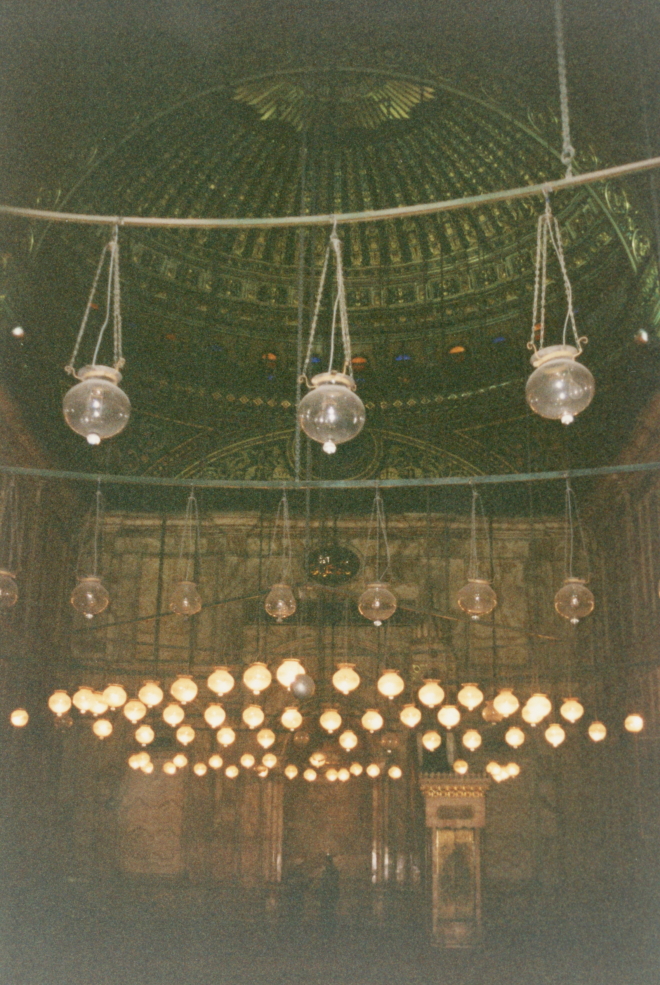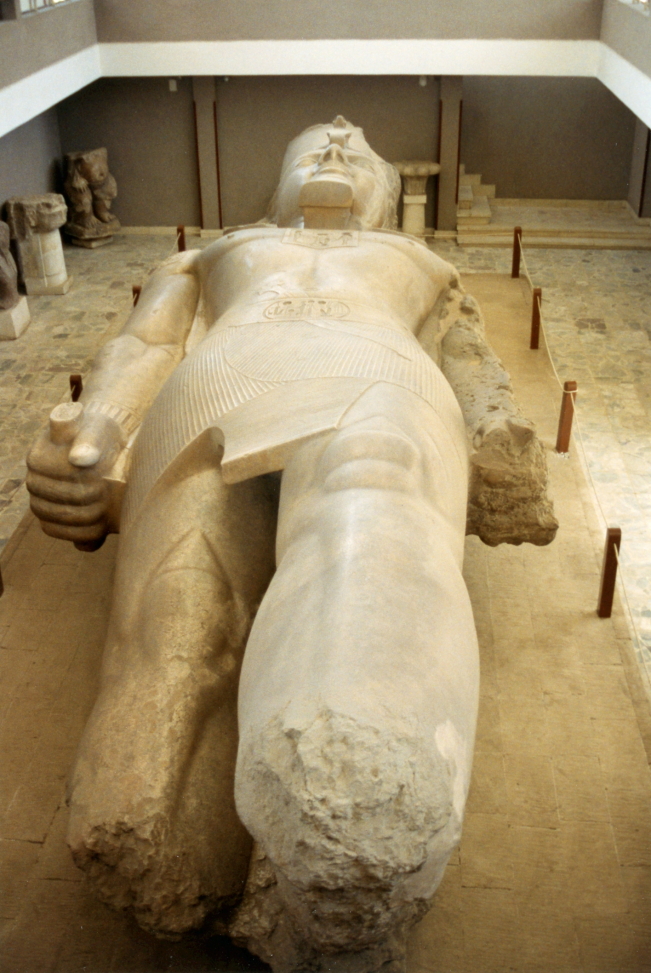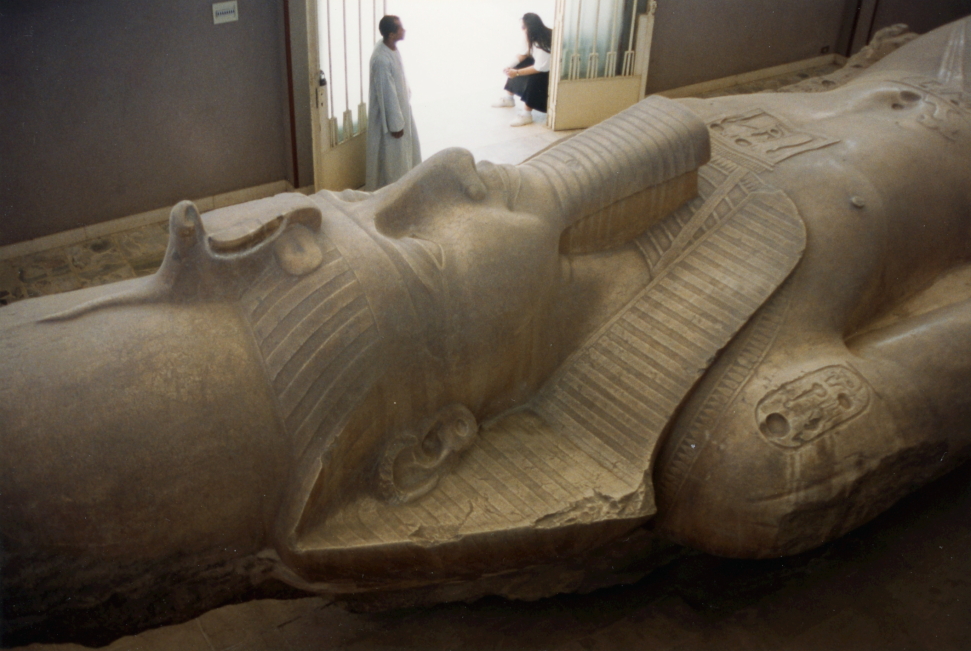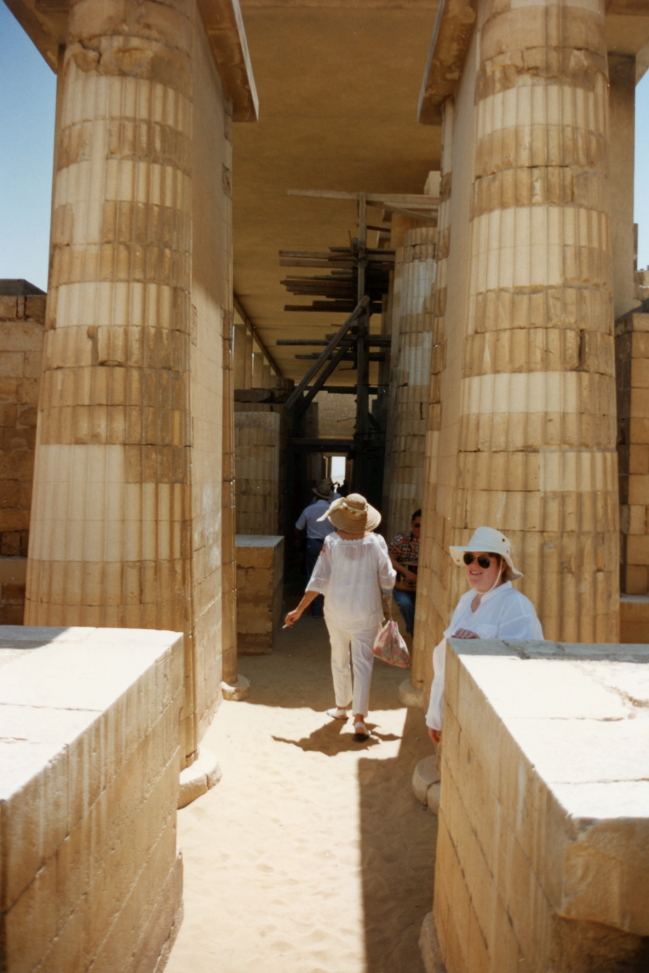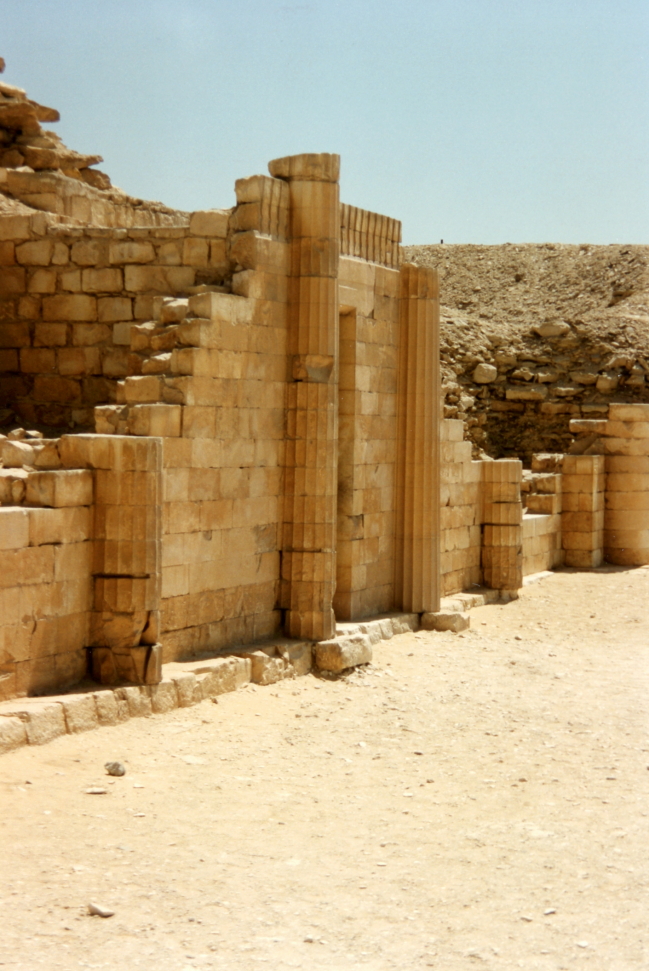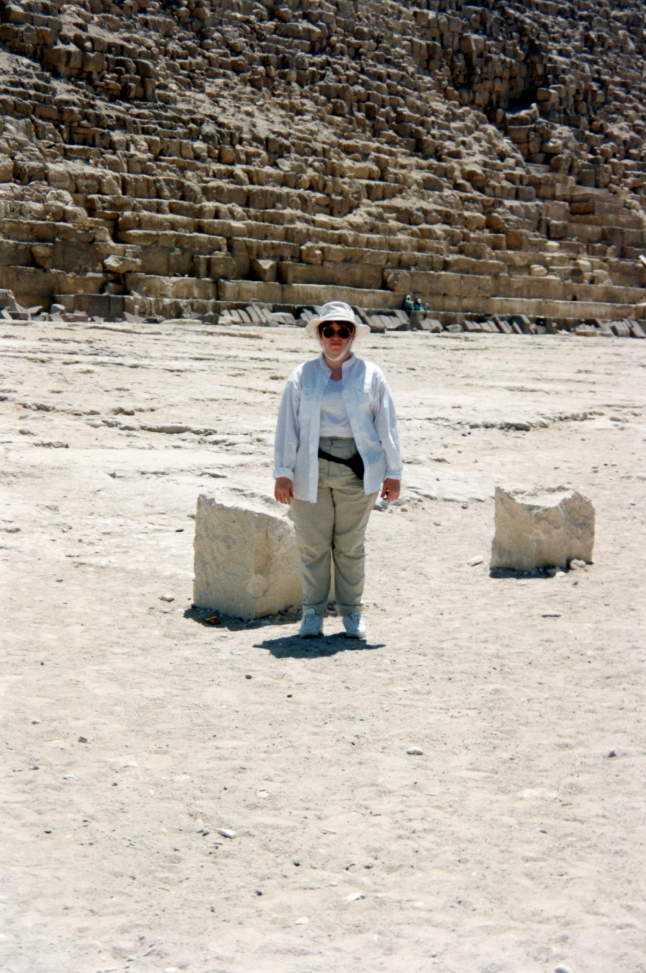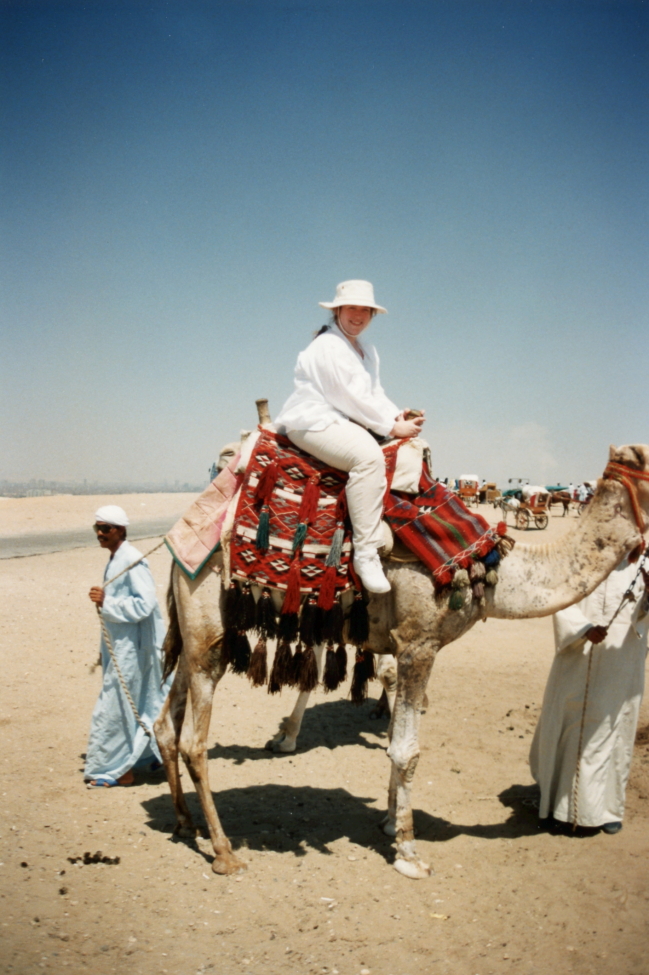Michelle writes:
The “salesmen” here can get trying. We just tried to go for a walk and every 10 feet or so someone tried to get us to take a taxi, take a horse carriage ride, etc. The pollution here is pretty bad. But with so many people and cars, what is to be expected?
We left at 9:00 again today. First we went to the Islamic Museum. This collection began in 1880’s. Sahar said that you could see the differences in style due to influences of other cultures. We saw a portable niche. This niche must be placed in the direction of Mecca. We saw some beautiful glass oil lamps. There was a beautiful saddle. There was a room of weapons, including arrows. There were also beautifully done manuscripts. Then we went to the Ibn Toulon Mosque. Ibn = son of. This mosque had the fountain in the middle and was open air. There was not a room in which to pray. They prayed outdoors (well under cover). The mosque had a nice minaret. Next we walked next door to see the Gayer Anderson House. This is 2 16th century houses joined by an elevated bridge.
Mashribiyya balconies were where women would sit. There were rooms here where only women or only men could sit.
There was a crocodile instrument. The bedrooms were very nice. The Persian one had inlaid work on all the walls and ceilings. The chairs were the folding up kind. Afterwards we went to visit the Coptic churches. We saw two of them. One was Al-Muallaka (The Hanging Church) -> it lies suspended across Roman towers that guarded the water entrance to the fortress. Oh, also at the G-A house, they had a room with birthing chairs. Back to the church. The marble pulpit was nice. It had 7 pairs of columns each different. They were suppose to represent the disciples and 2 gospels.
Next we went to Aba Serga (Saint Sergius). This is supposedly where the Holy family lived while Joseph worked at the fortress. There is a crypt which houses remains of the church where Jesus, Mary, & Joseph supposedly lived. But the crypt is now under water.
The last place we visited today was Keenest Eliahu (Ben Ezra Synagogue). This was build in 12th century. Americans helped to restore it, which set off a discussion between Brian & Mr. Hart. We got back to the hotel about 1:30. Mailed post cards.
Brian writes:
Weather: 90’s – Hot
Woke up at 6:15, ate breakfast – croissant and honey, and met the group at 9am. Went first to the Islamic Museum. Saw many objects from Islamic times — a fountain like the one in Manial Palace, but smaller (shorter), illuminated books (amazing – gold illuminations on blue – very detailed), swords, shields, and helmets and armor, like chainmail [ed – accompanied by simple illustrations]. Saw lots of inlaid boxes. Saw a travelling box that used to be used for food, the Islamic leaders have servants who taste everything before the leader does. Saw beautiful stained glass and the hanging lanterns used by the mosques. Also saw some very incredibly detailed gold jewelry – gold is considered only for the woman in Islam and many males even today wear silver bands. Also, many of the early Islamic designed (7th – 10th c.) are only floral or geometric, no animals or people. Later, animals and people are used. Also saw a portable niche that could be pointed towards Mecca while traveling. Saw some gorgeous rugs, and a saddle too. Saw a compass & astrolabe, and awesome map of the world (ancient). Saw examples of chandeliers and of wood work. Sahar said that mosque originally had wood roofs, but during the Mameluk times, when mosques of previous rulers were burned, wood roofs burned too easily.

Cairo street vendor

Cute Egyptian kitty cat
Next went to Ibn (= son of) Toulon Mosque, not far from the Islamic Museum. Its plan is like this [ed – map showing a fountain in the middle of a courtyard with a minaret on the side and covered sides]. This one is very old, ~8th c (?). During Mameluk times one rule was revolted against and went to Ibn Toulon for protection. They hid him in the minaret, and when the revolution was over he covered the mosque’s roof in wood work for them. Shortly thereafter, however, the practice was stopped. This, like the Mohammed Ali Mosque, also had a pulpit and a niche. The mosque, however, had no separate, indoor prayer area, it is all outdoors, on the left side. The open courtyard has lots of stones, not a good place to stand if people are pissed at you! The columns of the mosque were combined four-into one. A nice mosque, but Mohammed Ali was nicer.

Mosque of Ahmad Ibn Tulun (876 A.D.)

Michelle at Ibn Tulun, wearing the booties one must wear

Minaret at Ibn Tulun mosque

Fountain at Ibn Tulun mosque

Covered walkway surrounding Ibn Tulun’s courtyard

Lamp at Ibn Tulun mosque

Spiral minaret at Ibn Tulun

Ibn Tulun mosque
Next went to the adjacent Gayer-Anderson House. It is two 16th c. Arab houses connected by a suspended walkway. Beautiful courtyard. Each room has a theme, exterior mainly sandstone. Narrow, steep stairs. There was a room with replicas of Egyptian Antiquities like Nefertiti’s bust in the Berlin Museum. His bedroom (Anderson’s) was in “Syrian” style – very dark, lots of wood and red curtains – up a flight of stairs. He also had a Nubian maid who helped him. Anderson was a [ed – illegible] in the 1800’s or 1900’s and was a painter. Parts of the house, like the outdoor terrace with big folding tables and chairs, were for men. Others, like the [ed – illegible] room, were for women. The women’s rooms had wooden work all over the windows that allowed them to see vaguely what is going on outside without revealing self. Or, they could also open up little shutters in the woodwork to peep out of on to the street or room below. People below, however, can only see their eyes. No big deal [ed – illustration of a wood design window covering with a small open window shutter]. In main entertainment room, women’s chambers on second floor peer in, but are also covered w/ wood work. In entertainment room, there is the sunken fountain, area for dancers, musicians, then an area for the master of the house’s chair (in a corner) and other couches. Throughout the house are comfortable window seats and neat shelves in stairways [ed – illustration]. Saw a musical instrument – looked like a carved alligator, but on belly [ed – sorry Mom, I know you hate that word!] were strings. Clever. Finally, saw birthing chairs [ed – accompanying top-down diagram with handles pointed out]. Also a candle assembly. The showers, which is after the birth, is when a name is chosen. Everyone who wants to submits a name, and lights a candle the last candle to go out is the name chosen. Eliminates lots of family fights. All this in a separate room.
Next rode over to Old Cairo, where there was originally a Roman fort. On the two towers that used to guard the water entrance to the fort, a church was built [ed – illustration of church perched over two towers]. This Coptic church was called the “Hanging Church” b/c it “hung” over the Roman fortress. In Arabic it is El-Mallaqah (or somesuch). It was really cool. You entered, then went down a ramp into a courtyard then into the church itself. From the church, you could see the remains of the rounded Roman towers below – neat. The church was beautiful! Pillared inside, with Coptic cross ([ed – illustration of a Coptic cross]) banners in orange all about. Had light filtering on from high above, very beautiful. Pictures of the Saints were all about, and near icon was a painting of the Virgin Mary w/ Jesus and had eyes that followed you around. They also had 14 (?) pillars, each one a different shade of white in the church. One was black, however, for Judas. 12 were the apostles, plus 2 gospels. St. Antorius (?) and St. Peter brought Christianity to Egypt (Aegyptus to the Greeks and Romans) early in the 1st c. A.D. Then, Christians were heavily prosecuted [ed – should be persecuted]. Finally, after Christianity accepted in Empire, El-Mallaqah built in Roman Times. Christians in Egypt were called Copts, from Aegyptus, and has nothing to do with their religion, which is Greek Orthodox. The Coptic seat was in Alexandria a while too. Later, after the Muslims moved in, they demanded Copts pay higher taxes for “protection” since they are a minority. Those who cannot pay must convert to Islam or leave the country. Many Nubians, consequently, are Islamic, as could not afford to pay and were [ed – illegible] converted. Had pews like other churches.

Old Cairo alleyway

Al Muallaka, the Hanging Church

Pulpit in Al Muallaka Coptic church

Ruins of one of the Roman towers upon which the church is built
Next, weaved through twisting alley of Old Cairo to Abu Serga Coptic church. Fred actually asked “Why don’t they clean up, how can they live with all this dirt?” I was embarrassed, but he means well. It really wasn’t that dirty. The alleys were narrow, no wheeled traffic, about 6 feet across. Couple story buildings, dirt roads, numbers for houses painted in green on the side of the wall.

Another scene from Old Cairo

Our guide Sahar walks through Old Cairo
Not much to Abu Serga itself, just like any other building in Old Cairo. In need of repair, was encased in some scaffolding. Significant because this is where the Holy Family (Mary, Joseph, Jesus) stayed when Jesus was young and they were in exile. Stayed in a tiny cave beneath the church, which was built afterwards. Originally could go down to cave, where there is a tiny chapel, but the damming of the Nile has raised the subterranean water level so that the cave, and most of the flight of steps down to it, are submerged. Still Amazing!
Lastly, went a little farther to Ben Ezra Synagogue. Ben Ezra was built on the spot where Moses was supposedly found in the river (Nile) floating. It is beautiful, marble and wood throughout. The government, though, would only let the synagogue be built if it incorporated Islamic style art, which it does beautifully in its woodwork and geometric designs. The marble altar, with some of the Ten Commandments reproduced above, stands over an earlier, buried altar where Moses was found. There are only 120 Jews in all of Egypt, all Embassy workers [ed – Wikipedia says that as of 2016 there are six remaining, all women over 65, I’m assuming in addition to the Embassy workers]. Rest left after wars (1967 & 72). Our government funded the rebuilding of Ben Ezra which Bob Hart [ed – one of the people in our tour group] argued was stupid. I argued for historical preservation.

Interior or Ben Ezra Synagogue

Jeep Grand Cherokee in Cairo
Left Ben Ezra, went back to hotel ~2:00. Ate. ~4:00 – attempted to walk across bridge and Gezhira Island [ed – simple map], but had taxi drivers honk, carriage drivers bug us, and finally a guy who seemed to want me to vouch for his entry into U.S. Yeah, right! We aborted the mission. Mailed post cards, had dinner. Bed ~9:00.

View from the Cairo Sheraton

Cairo Tower on Gezira Island

Boats on the Nile

Yet another view of the Nile and boats

The Cairo Sheraton Cleopatra and Nefertiti towers













